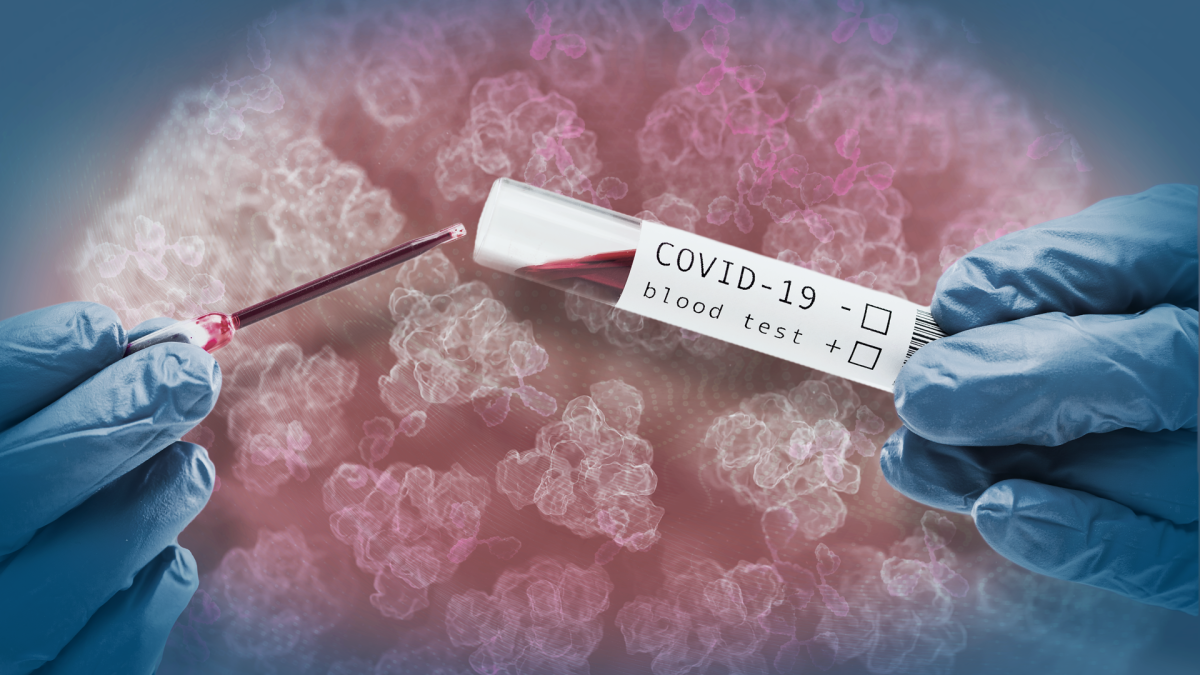ASU-led serosurvey boosts COVID-19 preparedness

ASU recruited 1,064 volunteers for a study tracking antibodies to the SARS-CoV-2 virus across the Tempe, Downtown, Polytechnic and West campuses. The interdisciplinary team found that 90% of participants had acquired antibodies against the spike protein of the virus, indicating previous COVID-19 vaccination. This was considerably higher than the general Arizona population vaccination rate of 58% at the time. Graphic by Jason Drees
While the COVID-19 pandemic has largely receded, at least for now, careful evaluation of vaccination and disease trends is essential for continuing public health efforts.
In September 2021, researchers at Arizona State University’s Biodesign Institute conducted a survey of students and staff to estimate how many people had acquired antibodies against SARS-CoV-2, the virus responsible for COVID-19.
The study is one of the first to estimate the seroprevalence of SARS-CoV-2 antibodies among a large and diverse population in a university setting. Seroprevalence refers to the proportion of individuals in a specific population who have detectable antibodies against a particular pathogen, and is a crucial indicator used to inform public health efforts.
The research is important for understanding the pervasiveness of immunity across the university population, whether due to past infection or vaccination, and for helping to design effective strategies that enable public health officials to stay a step ahead of the virus.
The study findings focus on the ASU community in Maricopa County, revealing crucial insights on infection rates and seroconversion — the process by which a person develops detectable antibodies in the blood as a response to an infection or vaccination.
The study was conducted over five days, from Sept. 13–17, 2021, at the Downtown Phoenix, Polytechnic, Tempe and West campuses of ASU.
“Seroprevalence studies are valuable tools in public health and epidemiology,” says Vel Murugan, corresponding author of the new study. “We were able to identify asymptomatic cases, vaccine coverage and assess the impact of communications and policies.”
Murugan is an associate research director and an associate research professor with the Biodesign Virginia G. Piper Center for Personalized Diagnostics. He is also an associate research director and an associate professor with the Biodesign Clinical Testing Laboratory.
The findings appear in the current issue of the open access journal BMJ Open.
On the hunt for antibodies
The researchers recruited 1,064 adult volunteers from ASU who represented various groups of students, faculty and staff. The participants were asked to provide demographic information, medical history and COVID-19 testing and vaccination status.
The study was conducted in the fall of 2021, when over 79,000 students returned to in-person learning. The testing coincided with the Delta variant surge, when Arizona was experiencing a flood of COVID-19 cases.
The interdisciplinary team found that 90% of participants had acquired antibodies against the spike protein of the virus, indicating previous COVID-19 vaccination. This was considerably higher than the general Arizona population vaccination rate of 58% at the time.
Serological tests were performed either at the ASU Biodesign Clinical Testing Laboratory or the Center for Personalized Diagnostics. To ferret out the antibody results across campus, researchers used two types of antibody tests: a lateral flow assay (LFA) and a semiquantitative chemiluminescent immunoassay (CLIA).
The lateral flow assay detects antibodies against the receptor binding domain (RBD) of the spike protein, which is the part of the virus that binds to human cells. The CLIA measures the level of anti-RBD antibodies in a blood sample.
The study also tested for antibodies against the nucleocapsid (N) protein, which is the structural protein of the virus. The N protein antibodies are usually produced by natural infection, but not by vaccination.
Tracking pervasiveness
The results showed that the prevalence of anti-RBD antibodies was 90% by LFA and 88% by CLIA, indicating a high level of immunity among the participants. The prevalence of anti-N antibodies was 20%, suggesting that one-fifth of the participants had been previously infected with SARS-CoV-2.
The study also found that individuals who had both natural infection and vaccination had higher levels of anti-RBD antibodies than those who had only one or the other. Further, the research revealed that individuals who had a breakthrough infection (e.g., tested positive for COVID-19 after being fully vaccinated) had the highest levels of anti-RBD antibodies.
The investigators further scrutinized elements that might influence antibody levels, including age, sex, racial or ethnic background, profession, pre-existing health conditions, symptom manifestation, the frequency of testing, and the kind of vaccine administered. The analysis revealed that elevated antibody levels were correlated with older age, being female, belonging to the Hispanic ethnic group, having pre-existing medical conditions, showing COVID-19 symptoms, undergoing tests more regularly, and receiving either the Pfizer or Moderna vaccines.
Additionally, while the researchers noted a decrease in antibody levels over time following either infection or vaccination, these levels remained above the protective threshold.
Health horizons
The study provides valuable information about the cumulative incidence of SARS-CoV-2 infection and the immune response to vaccination among the university community. The high level of immunity suggests that the university’s risk mitigation protocols, such as frequent testing, contact tracing, mask wearing and social distancing, have been effective in preventing widespread transmission of the virus.
The study also highlights the importance of booster shots for enhancing immunity, especially in light of the emergence of new variants of the virus. The researchers hope the findings will help inform future decisions regarding campus operations and public health policies.
The ambitious effort established the feasibility and effectiveness of conducting large-scale serological surveys using rapid antibody testing. These methods are convenient, inexpensive and scalable for monitoring the immune status of populations at risk of COVID-19 exposure.
The research underscores the importance of continuous monitoring, particularly in dynamic communities such as universities. Such studies can help researchers, clinicians, epidemiologists and public health workers navigate the evolving landscape of the pandemic.
More Science and technology

ASU-led space telescope is ready to fly
The Star Planet Activity Research CubeSat, or SPARCS, a small space telescope that will monitor the flares and sunspot activity…

ASU at the heart of the state's revitalized microelectronics industry
A stronger local economy, more reliable technology, and a future where our computers and devices do the impossible: that’s the…

Breakthrough copper alloy achieves unprecedented high-temperature performance
A team of researchers from Arizona State University, the U.S. Army Research Laboratory, Lehigh University and Louisiana State…


